Fused-Deposition Modeling 3D Printing of Short-Cut Carbon-Fiber-Reinforced PA6 Composites for Strengthening, Toughening, and Light Weighting
Abstract
:1. Introduction
2. Materials and Methods
2.1. Materials
2.2. Preparation of PA6-CF Composite Filaments
2.3. 3D Printing and Heat Treatment Process of PA6-CF Composites
2.4. Single-Layer Monofilament CF-OD Model and Fiber Orientation Testing Methods
2.5. Characterization of Material Micromorphology
2.6. Characterization of Thermal Properties of Materials
2.7. Characterization of Mechanical Properties of Materials
3. Results
3.1. Effect of CF Content and Printing Parameters on the Properties of PA6-CF Composites
3.1.1. CF Content
3.1.2. Printing Parameters
3.2. Analysis of the Effect of Heat Treatment Process on Mechanical Properties
3.2.1. Effect of Heat Treatment Process on Fiber Orientation of 3D-Printed Composites
3.2.2. Stereoscopic Fiber Orientation Distribution and Quantitative Analysis
3.3. Effect of Heat Treatment Process on Other Properties of 3D-Printed PA6-CF Composites
3.4. Exploration of Optimal Mechanical Properties of 3D-Printed PA6-CF Composites
3.5. Experiments on Lightweighting of 3D-Printed PA6-CF Composites
4. Conclusions
Supplementary Materials
Author Contributions
Funding
Institutional Review Board Statement
Data Availability Statement
Conflicts of Interest
Abbreviations
| PA6 | Polyamide 6 |
| TGA | Thermogravimetric Analysis |
| PA-CF25 | Polyamide with 25% Carbon Fiber |
| PA12 | Polyamide 12 |
| FDM | Fused-Deposition Modeling |
| ABS | Acrylonitrile Butadiene Styrene |
| CFRP | Carbon-Fiber-Reinforced Polymer |
| Tg | Glass Transition Temperature |
| DSC | Differential Scanning Calorimetry |
| Tc | Crystallization Temperature |
| ILSS | Interlaminar Shear Strength |
| CF-OD | Carbon Fiber Orientation Distribution |
| Td | Decomposition Temperature |
| CF | Carbon Fiber |
| SEA | Specific Energy Absorption |
| EM | Elasticity modulus |
| FRP | Fiber Reinforced Polymer |
| Xc | Crystallinity |
| GF | Glass Fiber |
| EA | Energy Absorption |
| PP | Polypropylene |
| PLA | Polylactic Acid |
| PEEK | Polyether Ether Ketone |
References
- Markandan, K.; Lai, C.Q. Fabrication, Properties and Applications of Polymer Composites Additively Manufactured with Filler Alignment Control: A Review. Compos. Part B Eng. 2023, 256, 110661. [Google Scholar] [CrossRef]
- Huang, Y.; Tian, X.; Wu, L.; Zia, A.A.; Liu, T.; Li, D. Progressive Concurrent Topological Optimization with Variable Fiber Orientation and Content for 3D Printed Continuous Fiber Reinforced Polymer Composites. Compos. Part B Eng. 2023, 255, 110602. [Google Scholar] [CrossRef]
- Rosén, T.; Hsiao, B.S.; Söderberg, L.D. Elucidating the Opportunities and Challenges for Nanocellulose Spinning. Adv. Mater. 2021, 33, 2001238. [Google Scholar] [CrossRef] [PubMed]
- Unterweger, C.; Duchoslav, J.; Stifter, D.; Fürst, C. Characterization of Carbon Fiber Surfaces and Their Impact on the Mechanical Properties of Short Carbon Fiber Reinforced Polypropylene Composites. Compos. Sci. Technol. 2015, 108, 41–47. [Google Scholar] [CrossRef]
- Love, L.J.; Kunc, V.; Rios, O.; Duty, C.E.; Elliott, A.M.; Post, B.K.; Smith, R.J.; Blue, C.A. The Importance of Carbon Fiber to Polymer Additive Manufacturing. J. Mater. Res. 2014, 29, 1893–1898. [Google Scholar] [CrossRef]
- Zhang, W.; Cotton, C.; Sun, J.; Heider, D.; Gu, B.; Sun, B.; Chou, T.W. Interfacial Bonding Strength of Short Carbon Fiber/Acrylonitrile-Butadiene-Styrene Composites Fabricated by Fused Deposition Modeling. Compos. Part B Eng. 2018, 137, 51–59. [Google Scholar] [CrossRef]
- Wong, J.; Altassan, A.; Rosen, D.W. Additive Manufacturing of Fiber-Reinforced Polymer Composites: A Technical Review and Status of Design Methodologies. Compos. Part B Eng. 2023, 255, 110603. [Google Scholar] [CrossRef]
- Khan, Z.I.; Mohamad, Z.; Rahmat, A.R.; Habib, U. Synthesis and Characterization of Composite Materials with Enhanced Thermo-Mechanical Properties for Unmanned Aerial Vehicles (Uavs) and Aerospace Technologies. Pertanika J. Sci. Technol. 2021, 29, 2003–2015. [Google Scholar] [CrossRef]
- Rana, S.; Bhattacharyya, A.; Parveen, S.; Fangueiro, R.; Alagirusamy, R.; Joshi, M. Processing and Performance of Carbon/Epoxy Multi-Scale Composites Containing Carbon Nanofibres and Single Walled Carbon Nanotubes. J. Polym. Res. 2013, 20, 314. [Google Scholar] [CrossRef]
- Li, X.; He, J.; Hu, Z.; Ye, X.; Wang, S.; Zhao, Y.; Wang, B.; Ou, Y.; Zhang, J. High Strength Carbon-Fiber Reinforced Polyamide 6 Composites Additively Manufactured by Screw-Based Extrusion. Compos. Sci. Technol. 2022, 229, 109707. [Google Scholar] [CrossRef]
- Cho, B.G.; Ram Joshi, S.; Hun Han, J.; Kim, G.H.; Park, Y. Bin Interphase Strengthening of Carbon Fiber/Polyamide 6 Composites through Mixture of Sizing Agent and Reduced Graphene Oxide Coating. Compos. Part A Appl. Sci. Manuf. 2021, 149, 106521. [Google Scholar] [CrossRef]
- Lupone, F.; Padovano, E.; Veca, A.; Franceschetti, L.; Badini, C. Innovative Processing Route Combining Fused Deposition Modelling and Laser Writing for the Manufacturing of Multifunctional Polyamide/Carbon Fiber Composites. Mater. Des. 2020, 193, 108869. [Google Scholar] [CrossRef]
- de Toro, E.V.; Sobrino, J.C.; Martínez, A.M.; Eguía, V.M.; Pérez, J.A. Investigation of a Short Carbon Fibre-Reinforced Polyamide and Comparison of Two Manufacturing Processes: Fused Deposition Modelling (FDM) and Polymer Injection Moulding (PIM). Materials 2020, 13, 672. [Google Scholar] [CrossRef] [PubMed]
- Han, S.; Chen, S.; Jiao, F. Insulating Polymers for Flexible Thermoelectric Composites: A Multi-Perspective Review. Compos. Commun. 2021, 28, 100914. [Google Scholar] [CrossRef]
- Tekinalp, H.L.; Kunc, V.; Velez-Garcia, G.M.; Duty, C.E.; Love, L.J.; Naskar, A.K.; Blue, C.A.; Ozcan, S. Highly Oriented Carbon Fiber–Polymer Composites via Additive Manufacturing. Compos. Sci. Technol. 2014, 105, 144–150. [Google Scholar] [CrossRef]
- Ning, F.; Cong, W.; Qiu, J.; Wei, J.; Wang, S. Additive Manufacturing of Carbon Fiber Reinforced Thermoplastic Composites Using Fused Deposition Modeling. Compos. Part B Eng. 2015, 80, 369–378. [Google Scholar] [CrossRef]
- Jiang, Z.; Diggle, B.; Tan, M.L.; Viktorova, J.; Bennett, C.W.; Connal, L.A. Extrusion 3D Printing of Polymeric Materials with Advanced Properties. Adv. Sci. 2020, 7, 2001379. [Google Scholar] [CrossRef]
- Sun, B.; Wu, L. Research Progress of 3D Printing Combined with Thermoplastic Foaming. Front. Mater. 2022, 9, 1083931. [Google Scholar] [CrossRef]
- Liao, G.; Li, Z.; Cheng, Y.; Xu, D.; Zhu, D.; Jiang, S.; Guo, J.; Chen, X.; Xu, G.; Zhu, Y. Properties of Oriented Carbon Fiber/Polyamide 12 Composite Parts Fabricated by Fused Deposition Modeling. Mater. Des. 2018, 139, 283–292. [Google Scholar] [CrossRef]
- Soleyman, E.; Aberoumand, M.; Soltanmohammadi, K.; Rahmatabadi, D.; Ghasemi, I.; Baniassadi, M.; Abrinia, K.; Baghani, M. 4D Printing of PET-G via FDM Including Tailormade Excess Third Shape. Manuf. Lett. 2022, 33, 1–4. [Google Scholar] [CrossRef]
- Soleyman, E.; Rahmatabadi, D.; Soltanmohammadi, K.; Aberoumand, M.; Ghasemi, I.; Abrinia, K.; Baniassadi, M.; Wang, K.; Baghani, M. Shape Memory Performance of PETG 4D Printed Parts under Compression in Cold, Warm, and Hot Programming. Smart Mater. Struct. 2022, 31, 085002. [Google Scholar] [CrossRef]
- Rahmatabadi, D.; Soltanmohammadi, K.; Aberoumand, M.; Soleyman, E.; Ghasemi, I.; Baniassadi, M.; Abrinia, K.; Bodaghi, M.; Baghani, M. Development of Pure Poly Vinyl Chloride (PVC) with Excellent 3D Printability and Macro- and Micro-Structural Properties. Macromol. Mater. Eng. 2023, 308, 2200568. [Google Scholar] [CrossRef]
- Wang, S.; Ma, Y.; Deng, Z.; Zhang, S.; Cai, J. Effects of Fused Deposition Modeling Process Parameters on Tensile, Dynamic Mechanical Properties of 3D Printed Polylactic Acid Materials. Polym. Test. 2020, 86, 106483. [Google Scholar] [CrossRef]
- Jiang, D.; Smith, D.E. Anisotropic Mechanical Properties of Oriented Carbon Fiber Filled Polymer Composites Produced with Fused Filament Fabrication. Addit. Manuf. 2017, 18, 84–94. [Google Scholar] [CrossRef]
- Wang, J.; Xie, H.; Weng, Z.; Senthil, T.; Wu, L. A Novel Approach to Improve Mechanical Properties of Parts Fabricated by Fused Deposition Modeling. Mater. Des. 2016, 105, 152–159. [Google Scholar] [CrossRef]
- Li, H.; Wang, T.; Sun, J.; Yu, Z. The Effect of Process Parameters in Fused Deposition Modelling on Bonding Degree and Mechanical Properties. Rapid Prototyp. J. 2018, 24, 80–92. [Google Scholar] [CrossRef]
- Kantaros, A.; Karalekas, D. Fiber Bragg Grating Based Investigation of Residual Strains in ABS Parts Fabricated by Fused Deposition Modeling Process. Mater. Des. 2013, 50, 44–50. [Google Scholar] [CrossRef]
- Caminero, M.A.; Chacón, J.M.; García-Moreno, I.; Reverte, J.M. Interlaminar Bonding Performance of 3D Printed Continuous Fibre Reinforced Thermoplastic Composites Using Fused Deposition Modelling. Polym. Test. 2018, 68, 415–423. [Google Scholar] [CrossRef]
- Wang, P.; Zou, B.; Ding, S.; Huang, C.; Shi, Z.; Ma, Y.; Yao, P. Preparation of Short CF/GF Reinforced PEEK Composite Filaments and Their Comprehensive Properties Evaluation for FDM-3D Printing. Compos. Part B Eng. 2020, 198, 108175. [Google Scholar] [CrossRef]
- El Magri, A.; El Mabrouk, K.; Vaudreuil, S.; Touhami, M.E. Mechanical Properties of CF-Reinforced PLA Parts Manufactured by Fused Deposition Modeling. J. Thermoplast. Compos. Mater. 2021, 34, 581–595. [Google Scholar] [CrossRef]
- Qu, M.; Nilsson, F.; Schubert, D.W. Effect of Filler Orientation on the Electrical Conductivity of Carbon Fiber/PMMA Composites. Fibers 2018, 6, 3. [Google Scholar] [CrossRef]
- Parandoush, P.; Zhou, C.; Lin, D. 3D Printing of Ultrahigh Strength Continuous Carbon Fiber Composites. Adv. Eng. Mater. 2019, 21, 1800622. [Google Scholar] [CrossRef]
- Duty, C.; Failla, J.; Kim, S.; Smith, T.; Lindahl, J.; Kunc, V. Z-Pinning Approach for 3D Printing Mechanically Isotropic Materials. Addit. Manuf. 2019, 27, 175–184. [Google Scholar] [CrossRef]
- Maqsood, N.; Rimašauskas, M. Characterization of Carbon Fiber Reinforced PLA Composites Manufactured by Fused Deposition Modeling. Compos. Part C Open Access 2021, 4, 100112. [Google Scholar] [CrossRef]
- Ismail, K.I.; Pang, R.; Ahmed, R.; Yap, T.C. Tensile Properties of In Situ 3D Printed Glass Fiber-Reinforced PLA. Polymers 2023, 15, 3436. [Google Scholar] [CrossRef]
- Yan, J.; Demirci, E.; Ganesan, A.; Gleadall, A. Extrusion Width Critically Affects Fibre Orientation in Short Fibre Reinforced Material Extrusion Additive Manufacturing. Addit. Manuf. 2022, 49, 102496. [Google Scholar] [CrossRef]
- Pibulchinda, P.; Barocio, E.; Favaloro, A.J.; Pipes, R.B. Influence of Printing Conditions on the Extrudate Shape and Fiber Orientation in Extrusion Deposition Additive Manufacturing. Compos. Part B Eng. 2023, 261, 110793. [Google Scholar] [CrossRef]
- Hou, W.; He, P.; Yang, Y.; Sang, L. Crashworthiness Optimization of Crash Box with 3D-Printed Lattice Structures. Int. J. Mech. Sci. 2023, 247, 108198. [Google Scholar] [CrossRef]
- Kmetty, Á.; Litauszki, K. Development of Poly (Lactide Acid) Foams with Thermally Expandable Microspheres. Polymers 2020, 12, 463. [Google Scholar] [CrossRef]
- Li, J.H.; Huang, X.D.; Durandet, Y.; Ruan, D. A Review of the Mechanical Properties of Additively Manufactured Fiber Reinforced Composites. IOP Conf. Ser. Mater. Sci. Eng. 2021, 1067, 012105. [Google Scholar] [CrossRef]
- Zhang, X.; Wang, J. Controllable Interfacial Adhesion Behaviors of Polymer-on-Polymer Surfaces during Fused Deposition Modeling 3D Printing Process. Chem. Phys. Lett. 2020, 739, 136959. [Google Scholar] [CrossRef]
- Markandan, K.; Kanaujia, P.K.; Abhineet, J.P.; Yap, X.Y.; Gan, C.L.; Lai, C.Q. Improvements in the Modulus and Strength of Multi-Dimensional Hybrid Composites through Synergistic Reinforcement between 1D Fiber and 0D Particle Fillers. J. Mater. Sci. 2021, 56, 15162–15179. [Google Scholar] [CrossRef]
- Yuan, L.; Shi, H.; Ma, J.; You, Z. Quasi-Static Impact of Origami Crash Boxes with Various Profiles. Thin Walled Struct. 2019, 141, 435–446. [Google Scholar] [CrossRef]
- Chen, J.; Hao, N.; Zhao, T.; Song, Y. Flexural Properties and Failure Mechanism of 3D-Printed Grid Beetle Elytron Plates. Int. J. Mech. Sci. 2021, 210, 106737. [Google Scholar] [CrossRef]
- Hu, D.; Wang, Y.; Song, B.; Dang, L.; Zhang, Z. Energy-Absorption Characteristics of a Bionic Honeycomb Tubular Nested Structure Inspired by Bamboo under Axial Crushing. Compos. Part B Eng. 2019, 162, 21–32. [Google Scholar] [CrossRef]
- Yu, X.; Zhang, X.; Chen, J.; Pan, L.; Xu, Y.; Fu, Y. Experimental Verification and Optimization Research on the Energy Absorption Abilities of Beetle Elytron Plate Crash Boxes. Mater. Res. Express 2019, 6, 1165e2. [Google Scholar] [CrossRef]


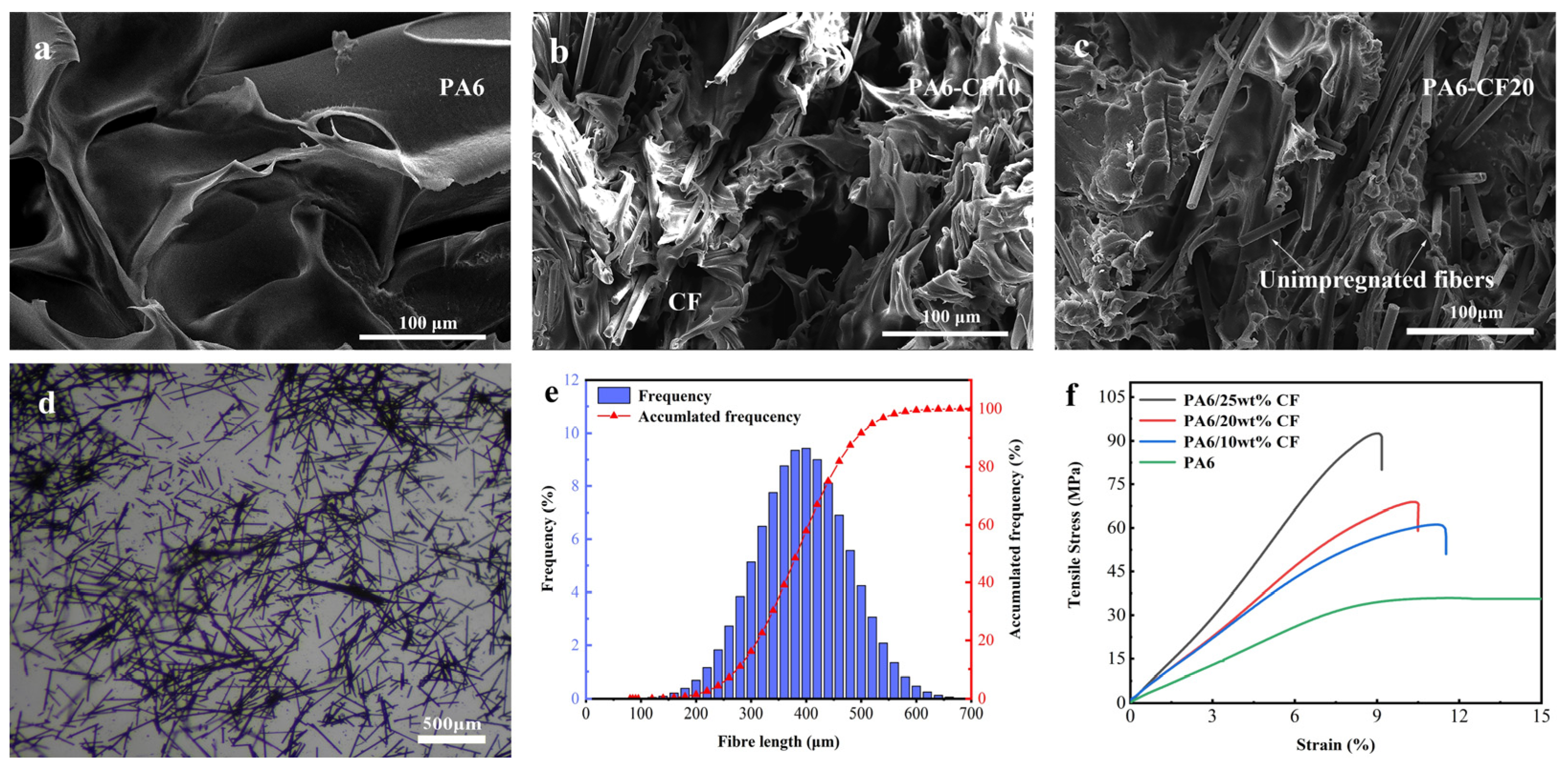

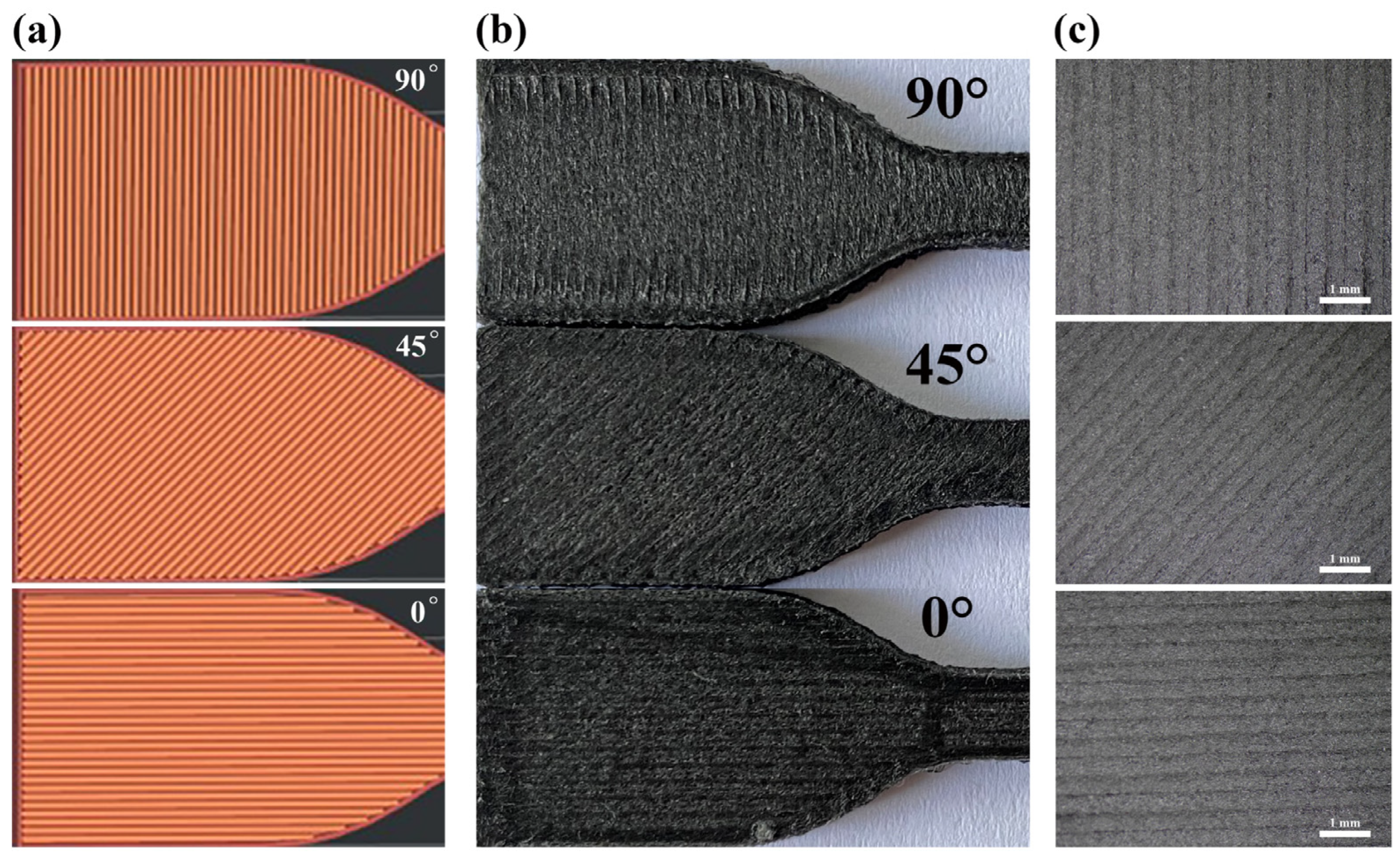




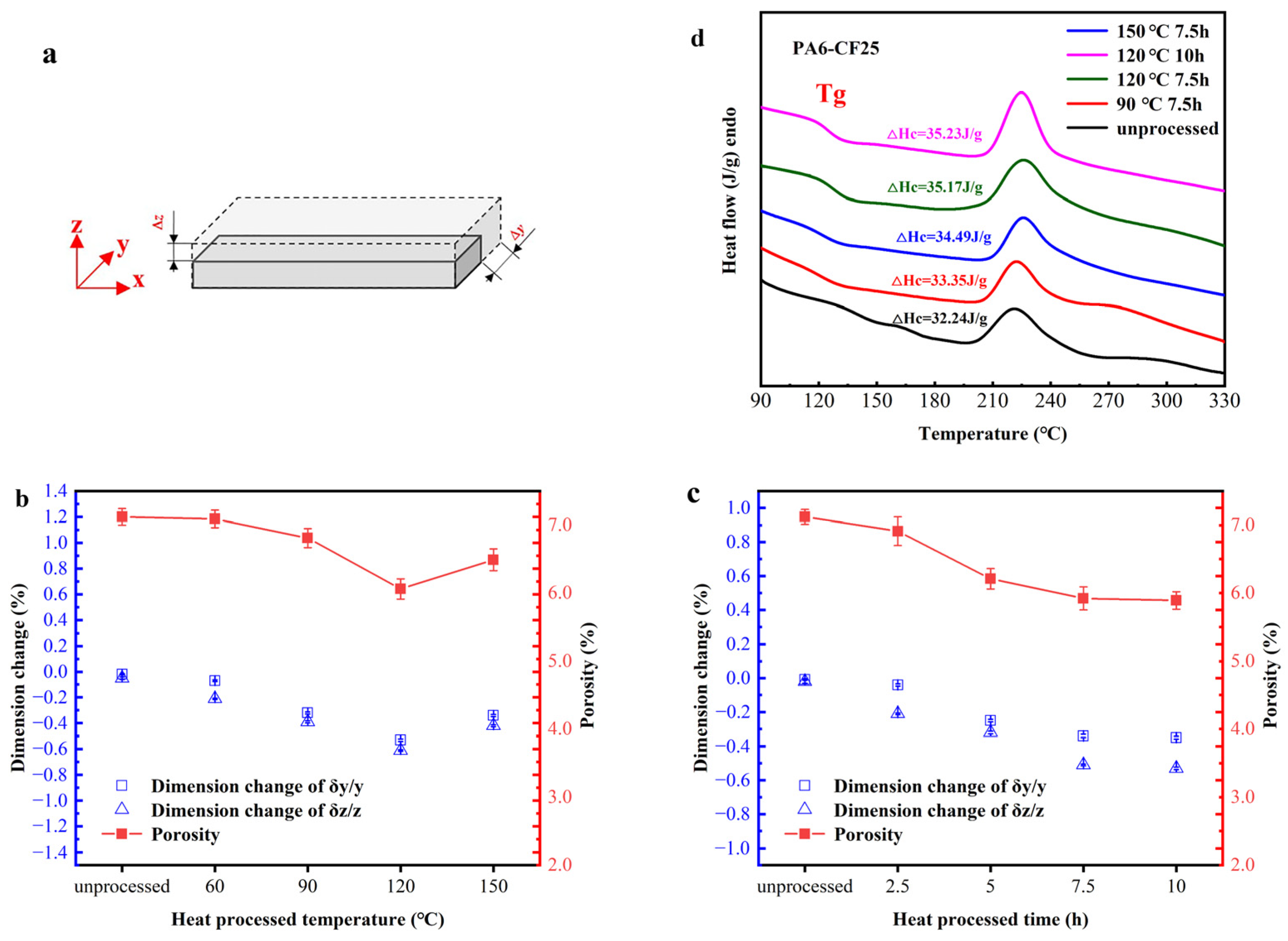

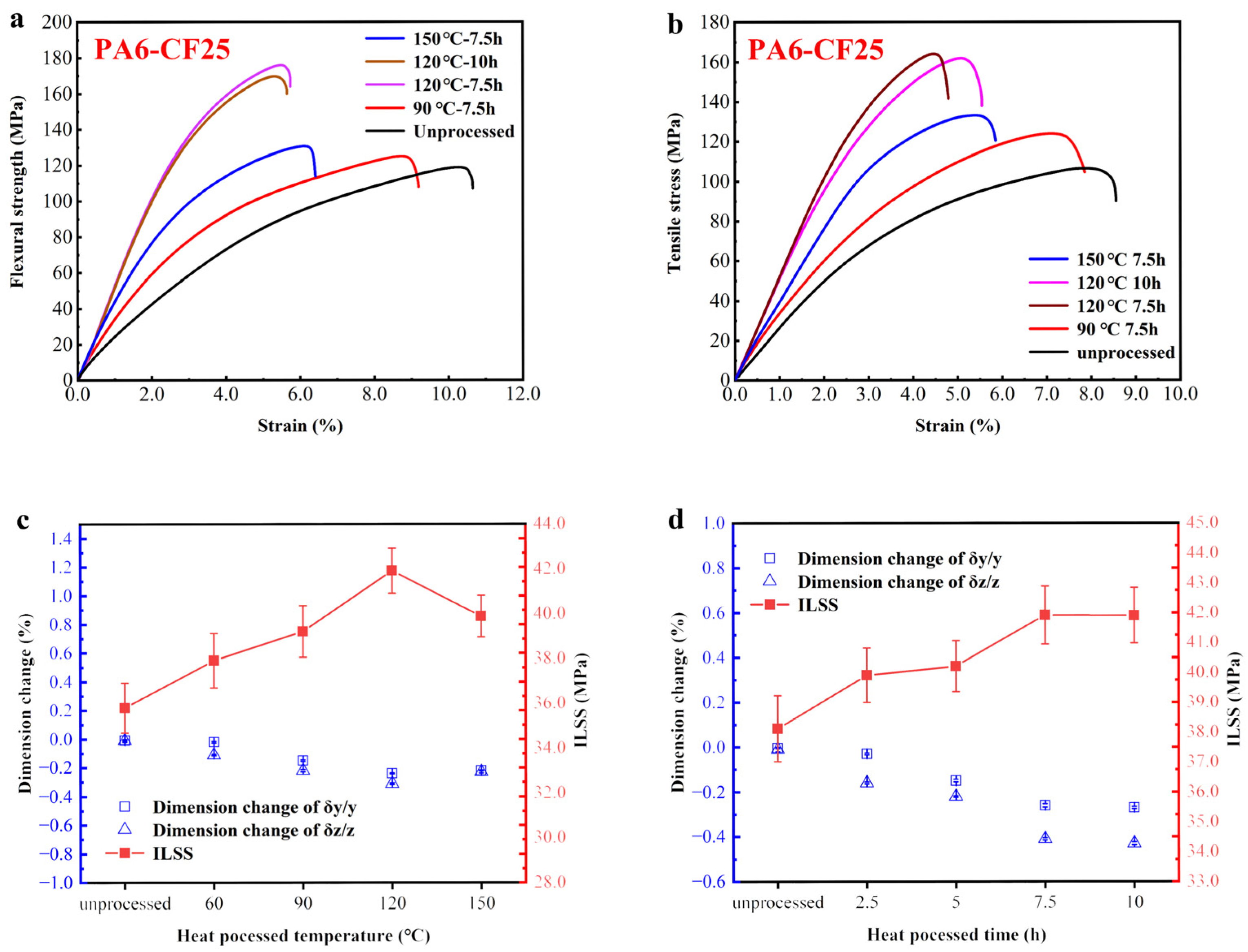
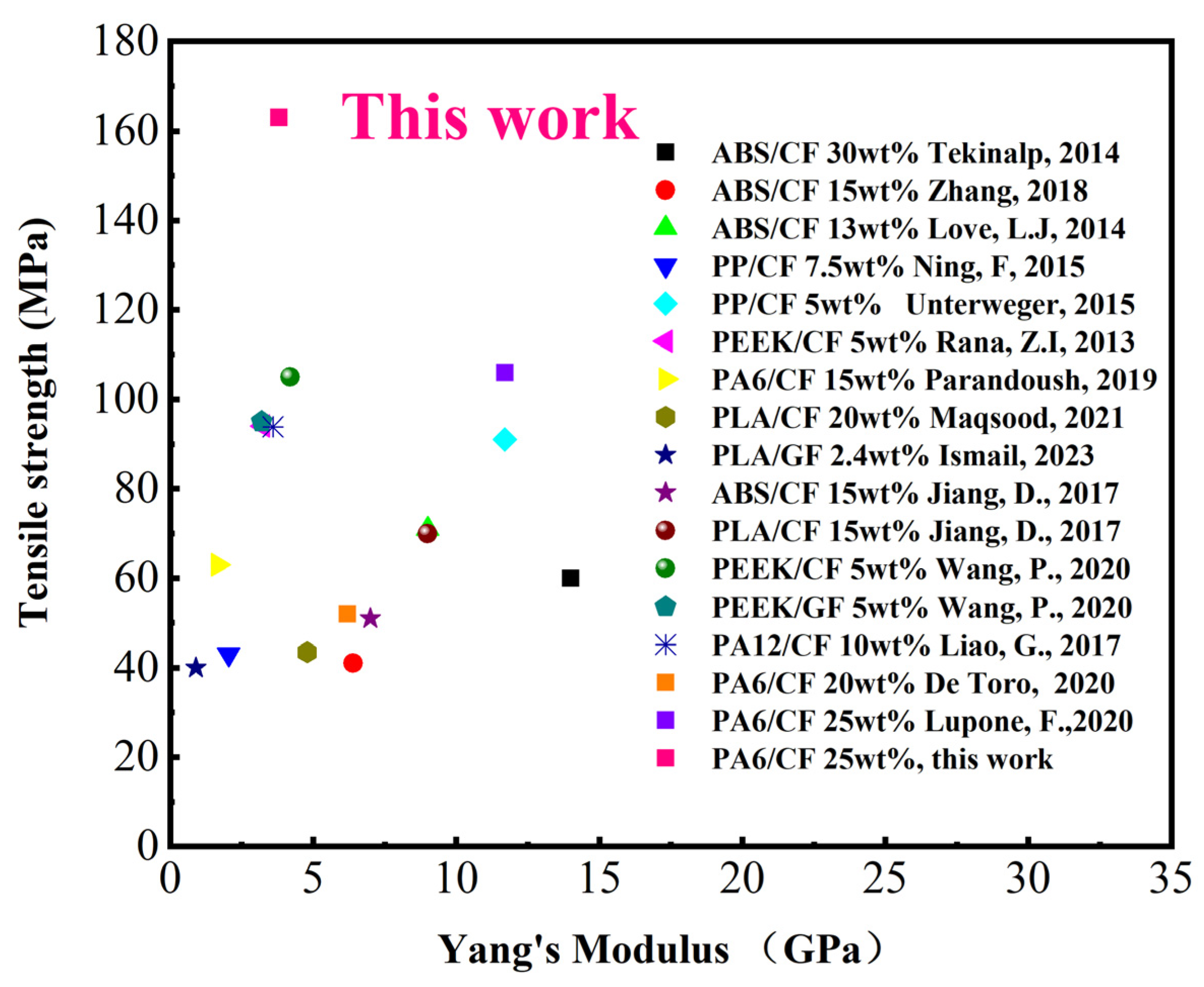
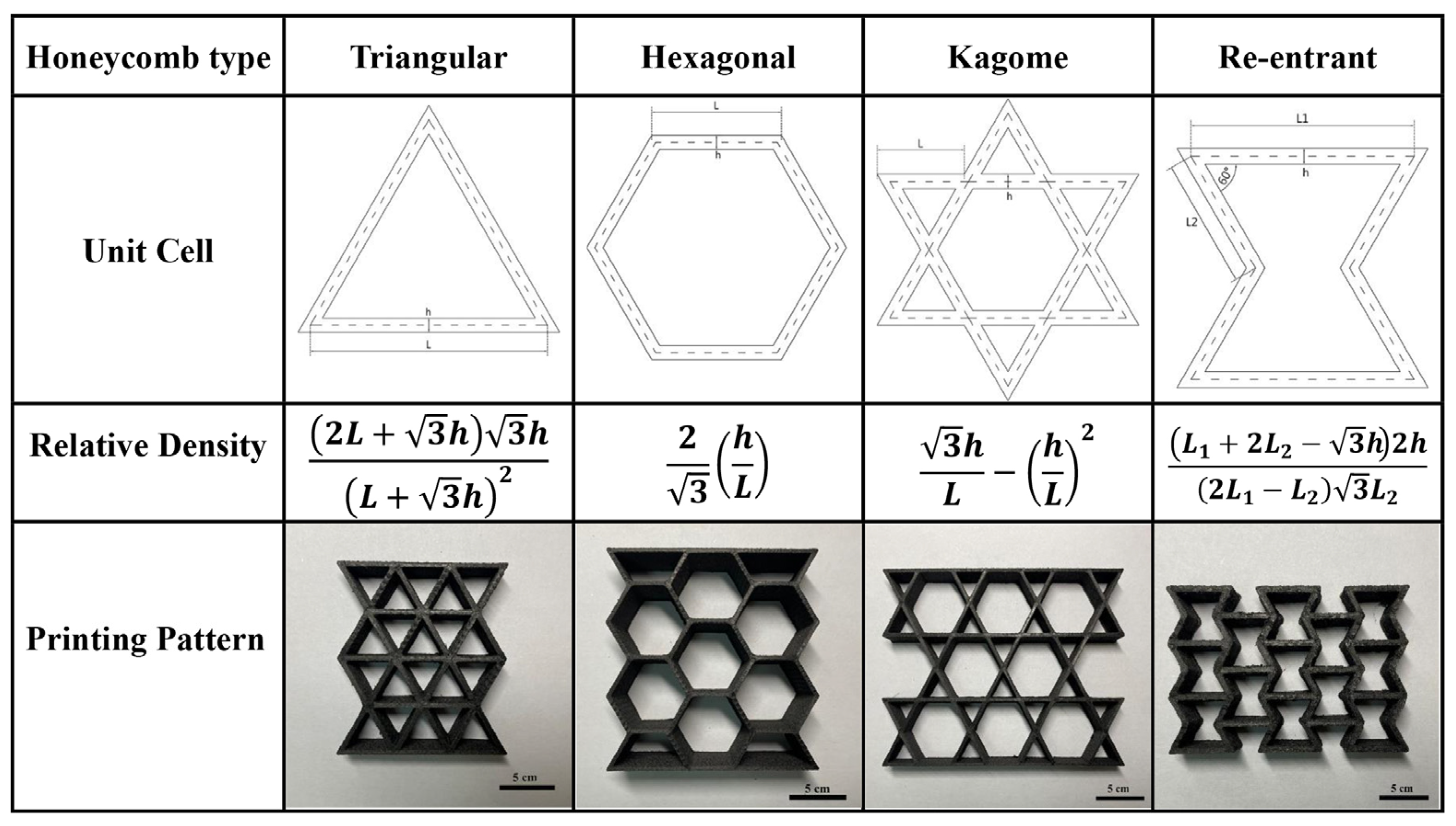

| Parameters | Value | Parameters | Value |
|---|---|---|---|
| Materials | PA6, PA6-CF10, PA6-CF20, PA6-CF25 | Build plate temperature | 60 °C, 90 °C |
| Infill structure | Triangular, Hexagonal, Kagome, Re-entrant | Layer thickness | 0.15 mm |
| Printing speed | 20 mm/s | infill density | 100% |
| X/Y axis movement speed | 150 mm/s | Nozzle temperature | 275 °C |
| Extrusion line width | 0.4 mm | Heat treatment temperature | rt, 90 °C, 120 °C, 150 °C |
| Raster angle | 0°, 45°, 60°, 90°, 135° | Heat treatment time | 0 h, 5 h, 7.5 h, 10 h |
| Sample (Fiber Contents/Raster Angle/Build-Up Temperature) | Tensile Strength (MPa) | Young’s Modulus (MPa) | Flexural Strength (MPa) | Impact Strength (kJ/m2) | Elongation at Break (%) |
|---|---|---|---|---|---|
| 10 wt%CF angle 135° T90 °C | 55.9 ± 1.9 | 489.3 ± 4.5 | 108.2 ± 1.3 | 11.8 ± 1.1 | 13.4 ± 0.2 |
| 10 wt%CF angle 90° T90 °C | 46.8 ± 2.8 | 424.5 ± 7.6 | 115.2 ± 1.9 | 9.2 ± 0.4 | 13.2 ± 0.2 |
| 10 wt%CF angle 45° T90 °C | 57.3 ± 1.8 | 492.3 ± 4.1 | 109.3 ± 0.9 | 11.1 ± 0.3 | 13.2 ± 0.1 |
| 10 wt%CF angle 0° T90 °C | 59.1 ± 2.0 | 513.5 ± 3.1 | 117.2 ± 2.1 | 13.1 ± 0.1 | 14.3 ± 0.5 |
| 20 wt%CF angle 135° T90 °C | 60.3 ± 2.3 | 582.8 ± 5.6 | 124.2 ± 1.3 | 15.1 ± 1.4 | 10.6 ± 0.2 |
| 20 wt%CF angle 90° T90 °C | 57.3 ± 2.5 | 551.2 ± 4.5 | 129.1 ± 1.7 | 12.1 ± 2.5 | 10.1 ± 0.1 |
| 20 wt%CF angle 45° T90 °C | 61.2 ± 1.8 | 560.2 ± 3.9 | 121.2 ± 2.3 | 15.2 ± 0.3 | 11.2 ± 0.4 |
| 20 wt%CF angle 0° T90 °C | 65.6 ± 2.0 | 604.2 ± 3.9 | 110.2 ± 1.1 | 14.1 ± 0.8 | 11.8 ± 0.5 |
| 25 wt%CF angle 135° T60 °C | 64.1 ± 2.5 | 614.0 ± 5.1 | 114.1 ± 1.2 | 17.2 ± 0.2 | 11.2 ± 0.3 |
| 25 wt%CF angle 90° T60 °C | 61.1 ± 1.2 | 568.9 ± 4.9 | 132.2 ± 2.1 | 15.1 ± 0.7 | 11.6 ± 0.4 |
| 25 wt%CF angle 45° T60 °C | 65.2 ± 1.9 | 616.1 ± 4.5 | 113.5 ± 0.7 | 15.4 ± 0.5 | 11.2 ± 0.7 |
| 25 wt%CF angle 0° T60 °C | 71.0 ± 2.3 | 641.2 ± 5.9 | 111.2 ± 1.5 | 17.3 ± 0.4 | 12.0 ± 0.2 |
| 25 wt%CF angle 135° T90 °C | 81.3 ± 1.7 | 791.01 ± 4.5 | 124.3 ± 2.4 | 24.0 ± 0.8 | 9.3 ± 1.0 |
| 25 wt%CF angle 90° T90 °C | 77.7 ± 2.1 | 711.48 ± 4.1 | 145.2 ± 2.3 | 26.1 ± 0.6 | 10.55 ± 0.9 |
| 25 wt%CF angle 60° T90 °C | 86.2 ± 1.1 | 877.2 ± 3.7 | 126.4 ± 3.1 | 23.1 ± 1.1 | 9.8 ± 1.1 |
| 25 wt%CF angle 45° T90 °C | 85.3 ± 1.0 | 862.38 ± 3.3 | 135.1 ± 1.3 | 21.1 ± 0.3 | 9.3 ± 0.4 |
| 25 wt%CF angle 0° T90 °C | 97.7 ± 2.1 | 1021.8 ± 9.1 | 123.1 ± 0.7 | 25.1 ± 0.2 | 11.7 ± 1.3 |
Disclaimer/Publisher’s Note: The statements, opinions and data contained in all publications are solely those of the individual author(s) and contributor(s) and not of MDPI and/or the editor(s). MDPI and/or the editor(s) disclaim responsibility for any injury to people or property resulting from any ideas, methods, instructions or products referred to in the content. |
© 2023 by the authors. Licensee MDPI, Basel, Switzerland. This article is an open access article distributed under the terms and conditions of the Creative Commons Attribution (CC BY) license (https://creativecommons.org/licenses/by/4.0/).
Share and Cite
Sun, B.; Mubarak, S.; Zhang, G.; Peng, K.; Hu, X.; Zhang, Q.; Wu, L.; Wang, J. Fused-Deposition Modeling 3D Printing of Short-Cut Carbon-Fiber-Reinforced PA6 Composites for Strengthening, Toughening, and Light Weighting. Polymers 2023, 15, 3722. https://doi.org/10.3390/polym15183722
Sun B, Mubarak S, Zhang G, Peng K, Hu X, Zhang Q, Wu L, Wang J. Fused-Deposition Modeling 3D Printing of Short-Cut Carbon-Fiber-Reinforced PA6 Composites for Strengthening, Toughening, and Light Weighting. Polymers. 2023; 15(18):3722. https://doi.org/10.3390/polym15183722
Chicago/Turabian StyleSun, Bin, Suhail Mubarak, Guocun Zhang, Kangming Peng, Xueling Hu, Qia Zhang, Lixin Wu, and Jianlei Wang. 2023. "Fused-Deposition Modeling 3D Printing of Short-Cut Carbon-Fiber-Reinforced PA6 Composites for Strengthening, Toughening, and Light Weighting" Polymers 15, no. 18: 3722. https://doi.org/10.3390/polym15183722
APA StyleSun, B., Mubarak, S., Zhang, G., Peng, K., Hu, X., Zhang, Q., Wu, L., & Wang, J. (2023). Fused-Deposition Modeling 3D Printing of Short-Cut Carbon-Fiber-Reinforced PA6 Composites for Strengthening, Toughening, and Light Weighting. Polymers, 15(18), 3722. https://doi.org/10.3390/polym15183722





